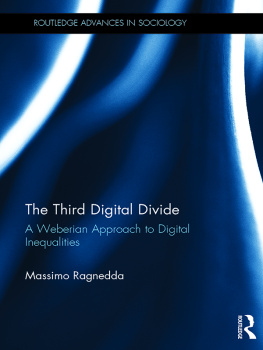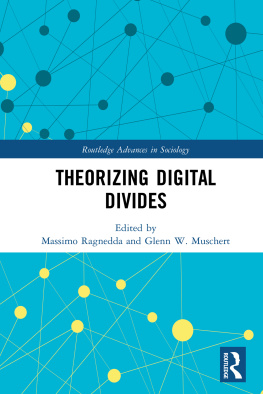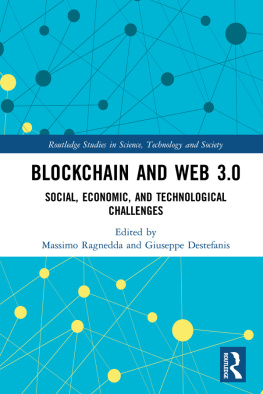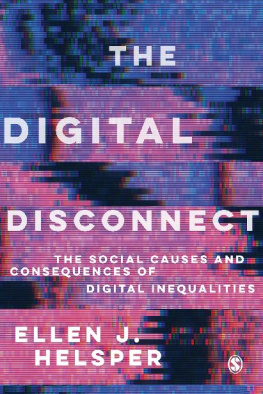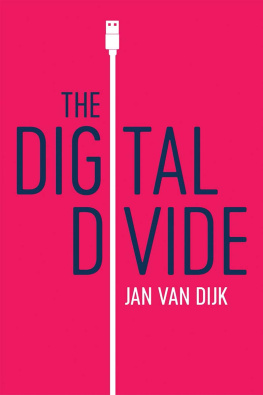The Third Digital Divide
Drawing on the thought of Max Weber, in particular his theory of stratification, this book engages with the question of whether the digital divide simply extends traditional forms of inequality, or whether it also includes new forms of social exclusion, or perhaps manifests counter-trends that alleviate traditional inequalities whilst constituting new modalities of inequality. With attention to the manner in which social stratification in the digital age is reproduced and transformed online, the author develops an account of stratification as it exists in the digital sphere, advancing the position that, just as in the social sphere, inequalities in the online world go beyond the economic elements of inequality. As such, study of the digital divide should focus not simply on class dynamics or economic matters, but cultural aspects such as status or prestige and political aspects such as group affiliations. Demonstrating the enduring relevance of Webers distinctions with regard to social inequality, The Third Digital Divide: A Weberian Approach to Digital Inequalities explores the ways in which online activities and digital skills vary according to crucial sociological dimensions, explaining these in concrete terms in relation to the dynamics of social class, social status and power. As such, it will be of interest to social scientists with interests in sociological theory, the sociology of science and technology, and inequality and the digital divide.
Massimo Ragnedda (PhD), is a Senior Lecturer in Mass Communication at Northumbria University, Newcastle, where he conducts research on digital divide and social media. He has authored six books with some of publications appearing in peer-reviewed journals and book chapters in English, Spanish and Italian.
Routledge Advances in Sociology
For a full list of titles in this series, please visit www.routledge.com/series/SE0511
191 European Social Integration and the Roma
Questioning Neoliberal Governmentality
Cerasela Voiculescu
192 How To Do Politics With Art
Edited by Violaine Roussel and Anurima Banerji
193 Urban Music and Entrepreneurship
Beats, Rhymes and Young People's Enterprise
Joy White
194 Multigenerational Family Living
Evidence and policy implications from Australia
Edited by Edgar Liu and Hazel Easthope
195 Sociology of Crisis
Myrto Tsilimpounidi
196 Praxeological Political Analysis
Edited by Michael Jonas and Beate Littig
197 Austere Histories in European Societies
Social Exclusion and the Contest of Colonial Memories
Edited by Stefan Jonsson and Julia Willn
198 Habermas and Social Research
Between Theory and Method
Edited by Mark Murphy
199 Interpersonal Violence
Differences and Connections
Edited by Marita Husso, Tuija Virkki, Marianne Notko, Helena Hirvonen and Jari Eilola
200 Online Hate and Harmful Content
Cross National Perspectives
Pekka Rsnen, Atte Oksanen, Matti Nsi and Teo Keipi
201 Science, Technology and the Ageing Society
Tiago Moreira
202 Values and Identities in Europe
Evidence from the European Social Survey
Edited by Michael J. Breen
203 Humanist Realism for Sociologists
Terry Leahy
204 The Third Digital Divide
AWeberian approach to digital inequalities
Massimo Ragnedda
The Third Digital Divide
A Weberian Approach to Digital Inequalities
Massimo Ragnedda

First published 2017
by Routledge
2 Park Square, Milton Park, Abingdon, Oxon OX14 4RN
and by Routledge
711 Third Avenue, New York, NY 10017
Routledge is an imprint of the Taylor & Francis Group, an informa business
2017 Massimo Ragnedda
The right of Massimo Ragnedda to be identified as author of this work has been asserted by him in accordance with sections 77 and 78 of the Copyright, Designs and Patents Act 1988.
All rights reserved. No part of this book may be reprinted or reproduced or utilised in any form or by any electronic, mechanical, or other means, now known or hereafter invented, including photocopying and recording, or in any information storage or retrieval system, without permission in writing from the publishers.
Trademark notice: Product or corporate names may be trademarks or registered trademarks, and are used only for identification and explanation without intent to infringe.
British Library Cataloguing in Publication Data
A catalogue record for this book is available from the British Library
Library of Congress Cataloging in Publication Data
Names: Ragnedda, Massimo, 1976- author.
Title: The third digital divide : a Weberian approach to digital inequalities / Massimo Ragnedda.
Description: Abingdon, Oxon ; New York, NY: Routledge, 2017. | Includes bibliographical references and index.
Identifiers: LCCN 2016036631 | ISBN 9781472471260 (hardback) | ISBN 9781315606002 (ebook)
Subjects: LCSH: Digital divide. | Information society. | Equality. | Weber, Max, 1864-1920.
Classification: LCC HM851 .R355 2016 | DDC 303.48/33--dc23
LC record available at https://lccn.loc.gov/2016036631
ISBN: 978-1-4724-7126-0 (hbk)
ISBN: 978-1-315-60600-2 (ebk)
Figures
Tables
This book uses the theoretical framework developed by Weber to analyse the phenomena of the digital divide and digital inequalities in relation to social stratification.
The aim of this book is thus to sketch a concept of stratification and inequalities in the digital sphere, in order to clarify whether the digital divide simply extends traditional forms of inequality, or whether it also includes new forms, which might include counter-trends that alleviate traditional inequalities and/or which form new modalities of inequality. As we shall see, inequalities that exist in the digital sphere are certainly entangled with inequalities present in the social sphere.
The discussion will proceed from a theoretical perspective using Max Webers theory of stratification in order to clarify how social stratification in the digital age is reproduced online. The main idea is that inequalities in the digital sphere are based on features that, just as in the social sphere, go beyond the economic aspects of inequality. To understand digital inequalities, the discussion should not focus only on class dynamics (economic aspects), but also status/prestige (cultural aspects) and group affiliations (political aspects). As in real life, social stratification in the digital sphere is the result of this complex interplay of three factors. These key distinctions Weber identified about social inequality are still significant in a digital age.
Thus, this book focuses on how online activities and digital skills vary according to crucial sociological dimensions, in order to explain these in concrete terms in relation to the dynamics of social class, social status and power. The Weberian approach, as I shall attempt to demonstrate, provides a richer understanding of both digital and social inclusion and exclusion that goes beyond a narrow class-based analysis. Furthermore, I shall discuss how the trajectories of citizens lives what Weber defined as life chances are affected by digital capital and Internet usage. Being on the wrong side of the digital divide may have seriously implications for individuals lives and life chances. To put it differently, being excluded from the digital realm, or not being able to make a full use of the potentiality offered by information communication technologies (ICTs), may dramatically affect ones opportunities to gain access to valued outcomes.

